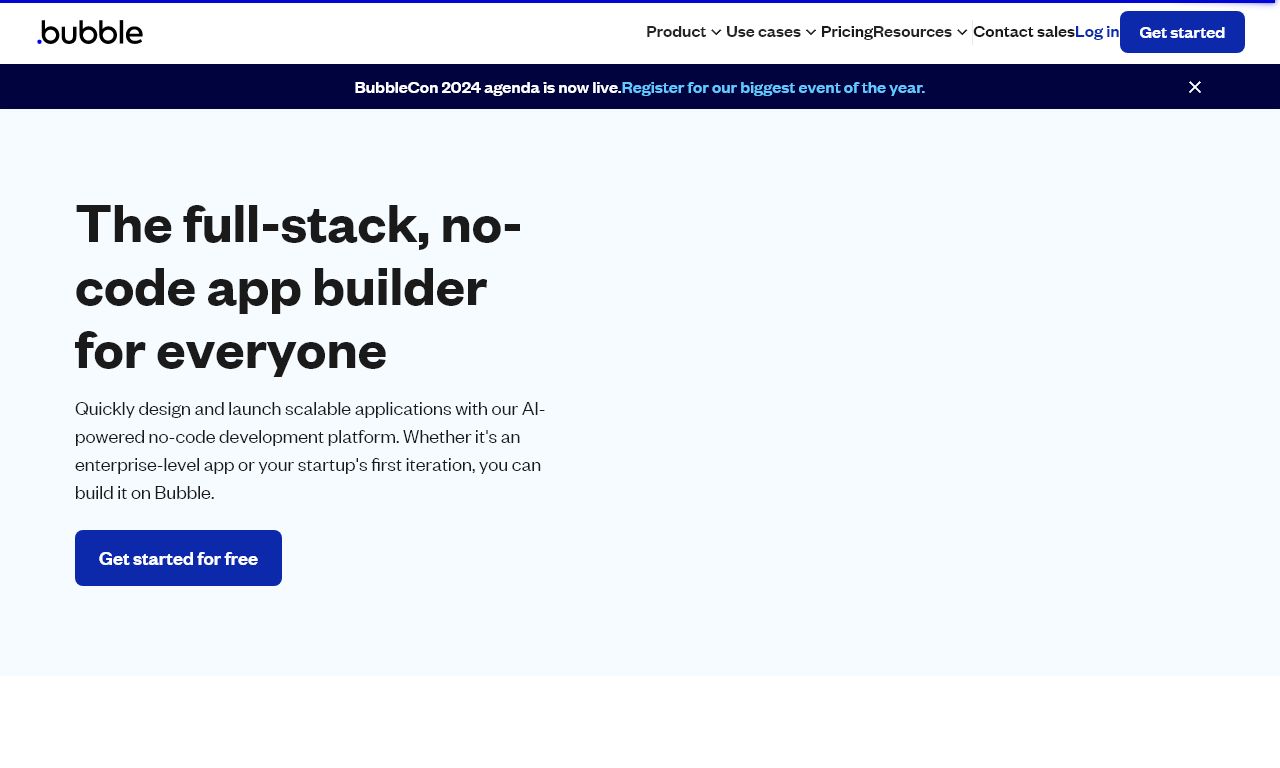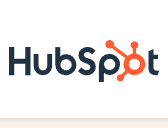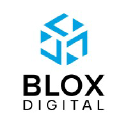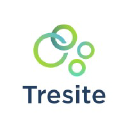
Bubble
Overview
Bubble is a no-code platform that allows users to build web applications without writing code. It provides a visual editor for creating the user interface, defining workflows, and managing data.
Key Features
- Visual programming: Build applications using a drag-and-drop interface
- Customizable design: Create custom user interfaces with the built-in design tools
- Workflow automation: Define complex app logic and automate processes
- Data management: Create and manage databases without writing SQL queries
- Responsive design: Build apps that work seamlessly on desktop and mobile devices
- Collaboration: Work with team members in real-time on the same project
- Scalability: Applications built on Bubble can scale to handle large amounts of traffic and data
- Integrations: Connect with external APIs and services to extend app functionality
Pricing
Bubble offers different pricing plans to suit various needs:
| Plan | Price | Key Features |
|---|---|---|
| Free | $0/month | Core platform features, community support, Bubble branding |
| Personal | $29/month | Core platform features, email support, custom domain, no Bubble branding |
| Professional | $129/month | All Personal features, plus API access, app metrics, and more |
| Production | $529/month | All Professional features, plus dedicated support, uptime SLA, and more |
Use Cases
Bubble can be used to build a wide range of web applications, including:- Marketplaces
- Social networks
- SaaS products
- Internal tools and dashboards
- Productivity apps
- And more
Getting Started
To start building apps with Bubble: 1. Sign up for a free account 2. Go through the onboarding tutorial 3. Start building your application using the visual editor 4. Preview and test your app 5. Publish your app and share it with others
Bubble
Bubble.io is a unique platform that blends the functionality of a content management system with powerful no-code development capabilities, revolutionizing the way businesses create and manage web applications.
This review explores the features and capabilities of Bubble.io, highlighting its strengths and potential limitations for users seeking a versatile web development solution.
1. Overview and purpose of the CMS
Bubble.io is a no-code platform that allows users to build web applications without writing traditional code.
It combines visual programming with database management, user authentication, and responsive design tools.
The platform's primary purpose is to empower entrepreneurs, startups, and businesses to create complex web applications quickly and efficiently.
2. User interface and ease of use
Bubble.io features a drag-and-drop interface that simplifies the process of building web applications.
The platform offers a visual editor for designing layouts and a logic editor for defining application behavior.
While the learning curve can be steep for complex applications, Bubble.io provides extensive tutorials and documentation to help users get started.
3. Content creation and editing tools
Bubble.io provides a range of tools for creating and editing dynamic content within web applications.
Users can design custom forms, create data structures, and implement conditional logic to display content.
The platform also supports rich text editing and media embedding for more traditional content management tasks.
4. Asset management capabilities
The platform includes an asset manager for organizing and storing images, videos, and other media files.
Users can upload assets directly to Bubble.io or integrate with external storage services like Amazon S3.
Bubble.io automatically optimizes images for web delivery, improving application performance.
5. Customization and extensibility options
Bubble.io offers extensive customization options through its visual interface and plugin ecosystem.
Users can create custom elements, define reusable components, and extend functionality with JavaScript and API integrations.
The platform's plugin marketplace allows for easy addition of pre-built features and integrations.
6. SEO features and optimization tools
Bubble.io provides basic SEO optimization tools, including customizable meta tags and URL structures.
Users can implement dynamic SEO content based on application data and user interactions.
However, advanced SEO features may require additional plugins or custom development.
7. Security measures and user management
The platform offers built-in user authentication and role-based access control for application security.
Bubble.io handles data encryption, secure connections (HTTPS), and regular security updates.
Users can implement additional security measures through plugins and custom workflows.
8. Performance and scalability
Bubble.io applications are hosted on Amazon Web Services (AWS), providing a scalable infrastructure.
The platform offers automatic scaling capabilities to handle increased traffic and data loads.
However, complex applications may require optimization and dedicated resources for optimal performance.
9. Integration with third-party tools and services
Bubble.io supports integration with a wide range of third-party services and APIs.
Users can connect to popular tools like Stripe, Zapier, and Google Analytics through built-in integrations or custom API calls.
The platform's plugin marketplace offers additional pre-built integrations for various services.
10. Pricing and support options
Bubble.io offers a tiered pricing model, including a free plan for learning and prototyping.
Paid plans start at $25/month and scale up based on features, usage, and support levels.
The platform provides email support, documentation, and a community forum for user assistance.
11. Mobile responsiveness and multi-device support
Bubble.io offers built-in responsive design capabilities, allowing applications to adapt to various screen sizes and devices.
The platform provides a responsive engine that automatically adjusts layouts and elements for mobile, tablet, and desktop views.
Users can fine-tune responsiveness using custom breakpoints and device-specific styling options.
12. Multilingual capabilities and localization features
Bubble.io supports multilingual applications through its built-in language editor and translation management system.
Users can easily add multiple languages to their applications and manage translations for all text elements.
The platform also allows for dynamic content localization based on user preferences or geolocation.
13. Workflow management and collaboration tools
Bubble.io provides version control and collaboration features for team-based development.
The platform offers a staging environment for testing changes before deploying to production.
Users can manage access permissions and collaborate on application development using shared workspaces.
14. Version control and content revision history
Bubble.io maintains a version history of application changes, allowing users to revert to previous versions if needed.
The platform provides a visual diff tool to compare changes between versions.
Users can also create and manage multiple versions of their applications for A/B testing or feature rollouts.
15. Analytics and reporting functionalities
Bubble.io offers built-in analytics to track user behavior and application performance.
Users can create custom events and track specific actions within their applications.
The platform integrates with popular analytics tools like Google Analytics for more advanced reporting capabilities.
16. E-commerce capabilities
While not primarily an e-commerce platform, Bubble.io supports building online stores and payment processing systems.
Users can integrate with popular payment gateways like Stripe and PayPal for secure transactions.
The platform allows for the creation of custom product catalogs, shopping carts, and order management systems.
17. Compliance with accessibility standards
Bubble.io provides tools to help developers create accessible applications that comply with WCAG guidelines.
The platform offers features like semantic HTML structure and ARIA attributes to improve accessibility.
Users can implement custom accessibility features using Bubble.io's extensibility options.
18. Documentation and learning resources
Bubble.io offers extensive documentation and tutorials to help users learn the platform.
The Bubble Manual provides comprehensive guides on all aspects of application development.
Users can access video tutorials, webinars, and interactive lessons through the Bubble Academy.
19. Community support and ecosystem
Bubble.io boasts a vibrant community of developers and users who share knowledge and resources.
The Bubble Forum serves as a hub for discussions, troubleshooting, and idea sharing.
The platform's ecosystem includes third-party agencies and consultants specializing in Bubble.io development.
20. Migration tools and processes from other platforms
Bubble.io provides data import tools to facilitate migration from other platforms.
Users can import data from CSV files or connect to external databases using API integrations.
While there are no direct migration tools for specific CMSs, Bubble.io's flexibility allows for custom migration solutions.
According to Bubble.io, over 1 million applications have been built on the platform, with users ranging from individual entrepreneurs to Fortune 500 companies.
Conclusion
Bubble.io offers a powerful and flexible solution for businesses looking to create web applications without traditional coding.
While it may have a steeper learning curve compared to traditional CMSs, its no-code approach and extensive feature set make it a compelling option for a wide range of web development projects.
As the no-code movement continues to grow, platforms like Bubble.io are likely to play an increasingly important role in democratizing web application development.
Website:















































